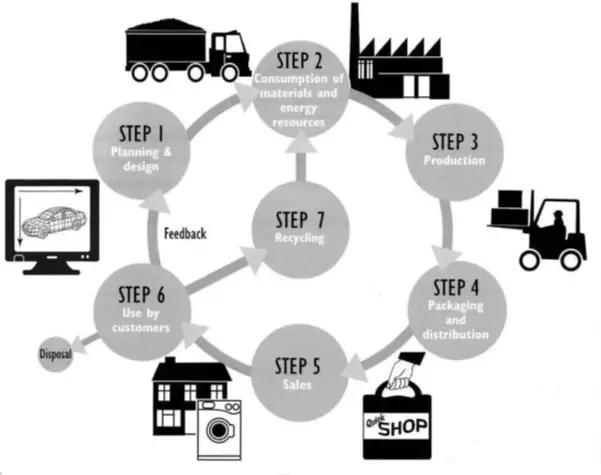» You should spend about 20 minutes on this task.
The diagram below shows the environmental issues raised by a product over its lifecycle. Summarise the information by selecting and reporting the main features, and make comparisons where relevant.
» You should write at least 150 words.

Sample Answer 1
The given diagram depicts the lifecycle of a product and the consequences due to its manufacturing. Generally speaking, most of the seven phases of production have a direct effect on the environment.
As is observed, the first step in the product manufacturing is planning and designing according to the needs. Then, the manufacturer starts to put the materials into action by consuming the required substances and energy resources, which lead to the third phase – production. It is clearly seen that these two steps have a direct impact on the environment. After that, the product undergoes packaging and distribution to shops and markets. Then, the product is sold to the consumers. Noting that packaging and sales might include adding covers on the product and using bags for selling it, which surely have a negative effect on the environment. Furthermore, after the product is consumed by the customers, it will have two possible destinations, disposing or recycling. Of course, disposing of the product makes it a burden to the environment while recycling it reduces the amount of the materials required for production. Finally, feedbacks are collected to help the designers in their upcoming plans.
[Author – Mo Alaa]
Sample Answer 2
The diagram illustrates environmental issues created by a consumer product during its lifecycle. It can be clearly seen that there are seven steps in the product manufacturing process, beginning with planning and design and culminating in recycling and these steps have negative consequences to the environment.
To begin with, the product manufacturing begins with the planning and design. Once it is complete, the next step, consumption of materials and energy resources, takes place which is followed by manufacturing of the product. These two steps consume natural resource and emit waste and CO2 which is detrimental to the environment.
Afterwards, the products are packed, distributed and offered in retail outlets. The products are unquestionably used by customers who either dispose the product or recycle it. Disposal of products seriously harms the environment. However, recycling of the product reduces negative impacts on the ecosystem. Moreover, customers provide feedback in order to improve the product planning.
